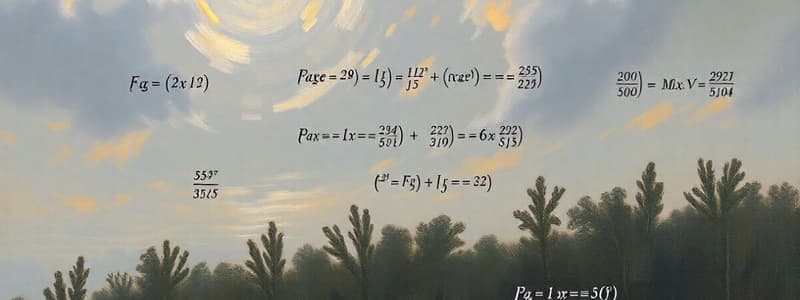Podcast
Questions and Answers
Which of the following correctly identifies the variable in the expression $5y + 7$?
Which of the following correctly identifies the variable in the expression $5y + 7$?
- y (correct)
- 5y
- 7
- 5
Which pair of terms are examples of like terms?
Which pair of terms are examples of like terms?
- $2x$ and $4y$
- $3x^2$ and $4x^2$ (correct)
- $5a$ and $5b$
- $2x$ and $3x$ (correct)
What is the result of simplifying the expression $2(4 + 3x) - 6$?
What is the result of simplifying the expression $2(4 + 3x) - 6$?
- $8 + 6x$
- $8 + 3x$ (correct)
- $12 + 6x - 6$
- $6 + 3x$
If you evaluate the expression $3x + 2y$ at $x = 1$ and $y = 4$, what is the value?
If you evaluate the expression $3x + 2y$ at $x = 1$ and $y = 4$, what is the value?
When combining like terms in the expression $6x + 4y - 2x + 3y$, what is the simplified expression?
When combining like terms in the expression $6x + 4y - 2x + 3y$, what is the simplified expression?
Match the following definitions with their correct terms:
Match the following definitions with their correct terms:
Match the following terms with their classification:
Match the following terms with their classification:
Match the following processes with their description:
Match the following processes with their description:
Match the following expressions with their simplified form:
Match the following expressions with their simplified form:
Match the following examples to their categories:
Match the following examples to their categories:
Flashcards are hidden until you start studying
Study Notes
Algebraic Expressions
- Definition: An algebraic expression is a combination of numbers, variables (letters representing numbers), and operations (+, −, ×, ÷).
Variables and Constants
-
Variables:
- Symbols (usually letters) that represent unknown values.
- Example: In the expression ( 3x + 2 ), ( x ) is a variable.
-
Constants:
- Fixed values that do not change.
- Example: In the expression ( 3x + 2 ), ( 2 ) is a constant.
Like Terms
- Definition: Terms that have the same variable raised to the same power.
- Examples:
- Like Terms: ( 4x ) and ( 2x ) (both have the variable ( x )).
- Unlike Terms: ( 4x ) and ( 3y ) (different variables).
- Combining Unlike Terms:
- Cannot be combined; keep them separate in an expression.
Simplifying Expressions
-
Process:
- Combine Like Terms: Add or subtract coefficients of like terms.
- Example: ( 3x + 4x = 7x )
- Use Distributive Property: Apply ( a(b + c) = ab + ac ) to eliminate parentheses.
- Example: ( 2(3 + x) = 6 + 2x )
- Combine Like Terms: Add or subtract coefficients of like terms.
-
Goal: Rewrite expressions in a simpler form, typically with the least number of terms.
Evaluating Expressions
-
Definition: The process of finding the value of an expression for given variable values.
-
Steps:
- Substitute the values for the variables into the expression.
- Perform Operations: Follow the order of operations (PEMDAS/BODMAS).
-
Example:
- Expression: ( 2x + 3y )
- Given values: ( x = 2 ), ( y = 3 )
- Evaluation: ( 2(2) + 3(3) = 4 + 9 = 13 )
Algebraic Expressions
- An algebraic expression combines numbers, variables, and operations.
- Variables are symbols representing unknown values like "x" in the expression 3x + 2.
- Constants are fixed values that don't change, like "2" in the expression 3x + 2.
Like Terms
- Terms sharing the same variable raised to the same power are considered like terms.
- Examples of like terms: 4x and 2x (both have variable 'x').
- Examples of unlike terms: 4x and 3y (different variables).
- Unlike terms cannot be combined and should be kept separate.
Simplifying Expressions
- Simplify by combining like terms through addition or subtraction of their coefficients.
- Example: 3x + 4x = 7x
- Use the distributive property to eliminate parentheses: a(b + c) = ab + ac.
- Example: 2(3 + x) = 6 + 2x
- The ultimate goal is to express an expression in a simpler form with the fewest possible terms.
Evaluating Expressions
- Find the value of an expression by substituting given variable values.
- Follow the order of operations (PEMDAS/BODMAS) to perform calculations after substituting values.
- Example:
- Expression: 2x + 3y
- Given values: x = 2, y = 3
- Evaluation: 2(2) + 3(3) = 4 + 9 = 13
Variables and Constants
- A variable represents an unknown number or value using a symbol, often a letter (e.g., x, y).
- A constant is a fixed value that remains unchanged (e.g., 3, -5, π).
- Algebraic expressions combine variables, constants, and mathematical operations (e.g., 2x + 3).
- Numerical expressions only include numbers and operations (e.g., 4 + 2).
Like Terms
- Like terms have the same variable(s) raised to the same power(s) (e.g., 3x and 5x, 2x^2 and -4x^2).
- Unlike terms differ in their variables or powers (e.g., 3x and 4y).
- Combining like terms involves adding or subtracting the coefficients of like terms (e.g., 3x + 5x = 8x).
Simplifying Expressions
- Simplifying expressions means rewriting them in their simplest form.
- The process involves:
- Identifying and combining like terms.
- Applying the distributive property when needed (a(b + c) = ab + ac).
- Removing parentheses by distributing or using the property of equality.
- Factoring common terms if applicable.
- Example:
- Start: 2x + 3x - 4 + 5
- Combine like terms: 5x + 1
- Simplified expression: 5x + 1.
- The aim is to make the expression easier to handle while maintaining its mathematical value.
Studying That Suits You
Use AI to generate personalized quizzes and flashcards to suit your learning preferences.





